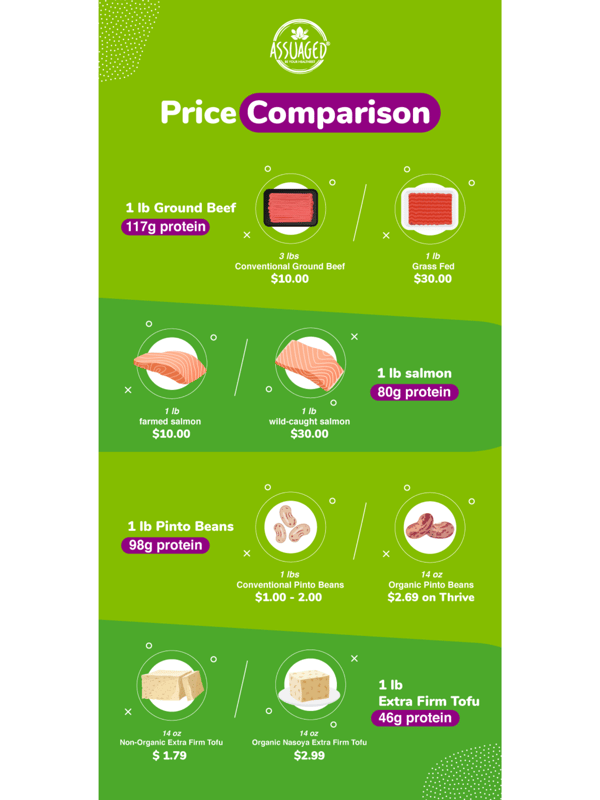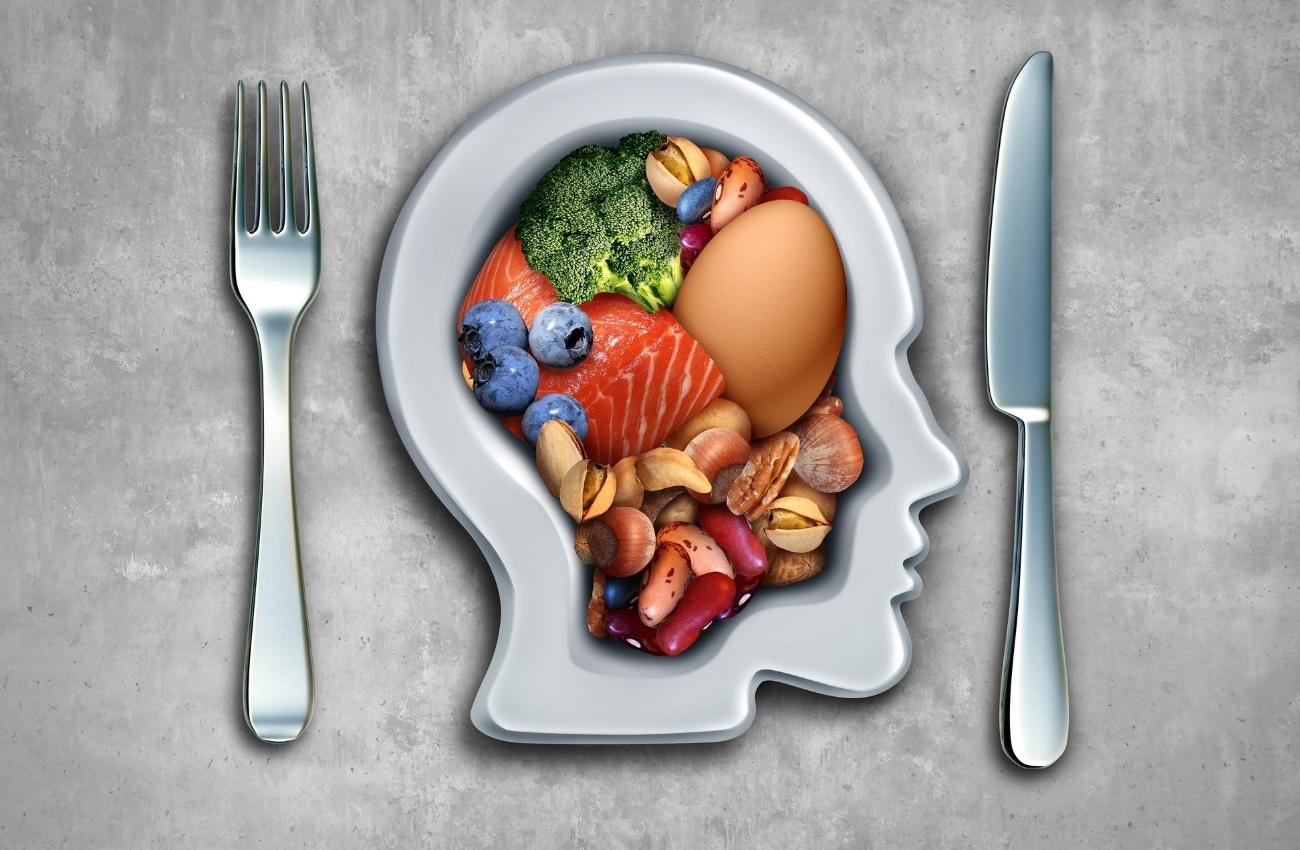Diet fads, weight loss and exercise programs, you name it; they’re as numerous these days as candies at a candy shop. While we wait for Mr. Joe Schmoe celebrity guy to tell us what the next best diet craze is this month, what if our motivation to eat healthy food disappears into thin air?
What if this unbearable urge to eat stuffed-crust Digiorno's pizza is waiting patiently for the right opportunity to hit us with a good old fashioned sucker punch to the gut? Wait, that might just a me problem. Moving along...
Don't despair! The age-old Paleo diet and the centenarian-rich Blue Zones diets stand the test of time!
The Paleo Cave Man Vs Plant-Based Centenarian
Beginning a diet can be difficult. Sticking with it isn’t easy either. It takes time, research, discipline, and enthusiasm to find what truly works because all our bodies are different. Those washboard abs won’t come swooping in like Tarzan swinging from a vine to save Mary Jane from the belly fat monster if you challenge yourself for a few weeks and then call it quits.
Start with smaller steps and try to figure out what works best for you. It'll take a bit of experimenting, but feeling your best is worth the investment of learning to listen to your body better. Getting rid of one thing at a time will give the clearest results of how food can affect you, both physically and mentally.
It can be argued that both the Blue Zones diet and the Paleo diet are impractical because they both place bans on or heavily limit different food groups that have been considered a staple of human society for hundreds of years.
Blue Zoners Cut Out the Following Dietary Go-To's:
- Eggs (limited)
- Meat (limited)
- Dairy
- Sugars
While Paleo Participants Omit These Common Food Items:
- Dairy
- Grains
- Beans
- Sugars
Blue Zone folk make a point of limiting eggs in their diet, but they are a big staple of the Hunter-Gatherer diet with high amount of omega 3 fatty acids, which are good for lowering blood pressure and reducing triglycerides. This lowers the risk of heart attacks or strokes.
The Paleo diet is the opposite of the Blue Zones diet in terms of how many calories they consume from meat and carbs. Blue Zoners get 50-80 percent of their caloric intake from plant-based carbs. Paleo dieters get 30 percent of their total calories from protein (primarily meat), which provides about 50 percent fat, and 30 percent carbohydrates.
But somehow, the two diets have some very similar qualities, including:
- Both diets restrict most if not all of the ingredients from processed foods.
- Both are high in fiber, potassium, and nutrients.
- Both eat very little if any sodium.
- Both diets restrict or omit sugar sources completely.
- Both call for clean, preferably local sources of meat and produce.
Wish you could get fresh, organic, affordable pre-made meals sent to your door to make your families' weeknights less hectic and more healthy? Try any of the many mail-order meal kits and see if one works for you.
The Paleo Diet's Primary Downfall - Price
The main issue with the Paleo diet is that it can be pretty expensive and there's no defined measurement of calories and portions that you should eat. The Paleo diet is healthy and great for weight loss if done right, but there's no limit to how much Paleo dieters can eat.
Here's a price comparison between conventional meat prices and their grass-fed alternatives with some plant-based product prices added into the mix:
The Paleo diet is a great place to start for people with lactose intolerance. It omits all dairy products. It's also good for those with gluten intolerance because they cut out grains as well! This is especially true for anyone suffering from eczema because either of these diets helps to soothe flare-ups immensely.
We're constantly updating our Dairy-Free and Gluten-Free recipes. Remember, you're always welcome to share your plant-based recipes with the Assuaged community on our ➡️Share your Recipe⬅️ Page!
The Paleo Diet - What Did Cavemen Eat?
Paleo is short for Paleolithic - the period of human development over 2.5 million years ago; well before the advent of the grocery store. Humans only ate foods that were readily available.
Yes, this spans back far before the invention of agriculture. And before you ask, no. They didn’t even have Instacart. These pre-Facebook humans had to adapt genetically to their limitations in food supply to become healthier and stronger.
Advocates for this animal based, low-carbohydrate diet argue that there's too little a time frame between the Paleolithic era and the Facebook era for the human body to adapt to our new diets. They even say that this lack of adaptation is responsible for diabetes and obesity.
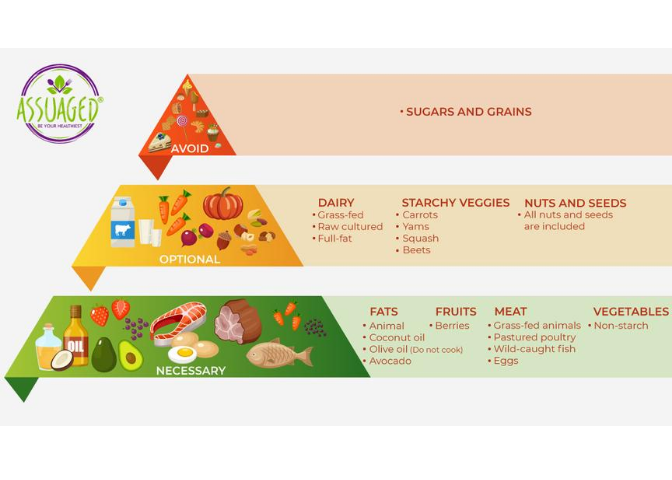
The Caveman Diet Includes These Foods:
- Grass-fed proteins
- Wild seafood
- Eggs
- Nuts
- Plant-based oils
- Fibrous veggies
- Fruit - only to a small degree
Paleo restricts food groups that theoretically, prehistoric humans would not have eaten. These include:
- Grains
- Legumes and pulses (soybeans and peanuts included)
- Refined sugars
- Artificial sweeteners
- Dairy
- Salt
What Do the Blue Zone Centenarians Eat?
As the old adage goes, you are what you eat. The measure of a Blue Zoner’s stomach consists of a 95 percent vibrant and thriving plant-based diet full of top longevity foods.
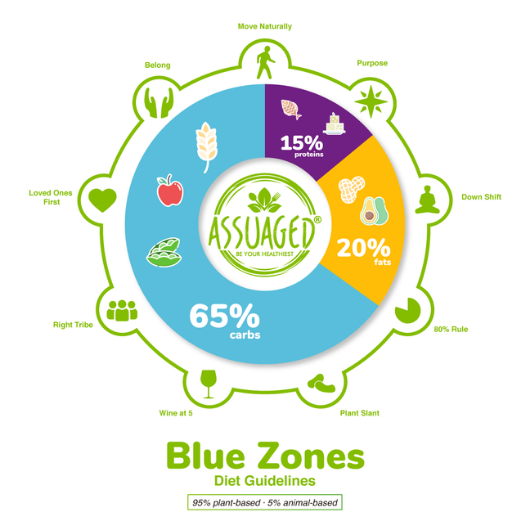
100% Whole Grains:
The richer they are in fiber, the better. They average about 10-15 grams of fiber per day.
- Whole grain bread
- Barley
- Brown rice
- Bulgur Wheat
- Farro
- Quinoa
- Oatmeal
- Whole cornmeal
Although the USDA recommends that we eat 25-35 grams daily, most Americans don't get enough fiber from their current diets.
Nuts (Unsalted), Raw, or Lightly Toasted:
Blue Zone folk typically eat about two handfuls of nuts per day, ranging from:
- Almonds
- Cashews
- Hazelnuts
- Pistachios
- Walnuts
- Brazil nuts
- Peanuts
Just about all nuts are included, in 1-2 ounce portions per serving. They also aren’t averse to eating nuts alone, but they mix nuts with other things, too. (E.g., stew with almonds, cashews in stir-fry).
Beans, Legumes, and Pulses:
Blue Zoners eat approximately one cup of beans per day.
- Kidney beans
- Great northern beans
- Black beans
- Pinto beans
- Lentils
- Split peas
- Chickpeas
Fun fact: Tofu is made from fermented soybeans. In Okinawa, tofu is eaten every day in addition to rice.
Not sure what to make for dinner while transitioning into a plant-based diet? There are so many great fresh ready-made options to try while collecting new ideas and expanding the tastebud's horizons...
Purple Carrot - $30 Off! Use code: carrot30
Wow, that's a lot of carbs!
All of those legumes, whole wheats, and nuts are surely packed with carbs! But it’s the type of carbs that count. Blue Zoners eat about 50-80 percent complex carbohydrates; unprocessed, full of fiber with big, long molecular chains that scream, "Eat me! I’m nutritious!"
Carbs often get a bad rap in the West because of all of the processed, simple carbohydrates that are cheap and readily available at almost every major food chain. When balanced with proteins and healthy fats, the magical trio does wonders for health and energy levels!
Locally Sourced, Clean Meat:
Blue Zoners use a chart that rates seafood options via a green, yellow and red system based on mercury content and sustainability. The green options are the best. They include:
- Salmon
- Sardines
- Mussels
- Rainbow trout
- Atlantic mackerel
In 4 out of the 5 Blue Zones, fish are eaten regularly, but not much else. They prefer to eat meat as an act of celebration. For semi-regular meals, they eat middle-of-the-food-chain species as a small side, like anchovies, cod or sardines. Blue Zone folk eat fish up to 3 days per week and only around 3 ounces per day.
All Native and Seasonal Fruits
Fruits are less common in most of the five native diets because they're just not as common in the local vicinity, but they're still incorporated when available. Most people in these regions have personal or community gardens that they get fresh, nutrient rich produce from, straight from ground to table in the same day. This provides Blue Zoners with amazing produce and natural daily exercise.
- Citrus Fruits
- Berries
- Apples
- Bananas
- Dates
- Papayas
- Unsweetened dried fruits
Fun fact: Many Blue Zone folk love their lemons. They even eat the skin. Not like an apple, of course. They often use it for zesting in other meals, adding a healthy dose of vitamin C and antioxidants to their mix, along with a flavorful twist.
All Local and Seasonal Vegetables
Many Blue Zoners fill a cup with these veggies in almost every meal. They also mix these with main dishes, including soups and stews. Onions and garlic are also a favorite. These vegetables are alliums that have strong antioxidants that boost immune systems. This is one of the ways among many that Blue Zoners are winning in the fight against cancer.
- Kale
- Avocado
- Rainbow chard
- Fennel
- Collard greens
- Spinach
- Sweet Potatoes
- Mushrooms
- Seaweed and nori
- Turmeric
- Tomatoes
The Blue Zone folk don't eat foods with:
- Brown sugar
- Raw sugar
- High fructose corn syrup
- Glucose
These sweeteners are found in:
- Dairy products
- White bread
- Baking goods
- Cereals
- Fruit juices
- Soft drinks
- Snacks
Blue Zone folk avoid just about any processed foods, instead eating complex carbs that add years to their lives. Saying no to simple carbohydrates and sugars not only helps prevent energy crashes, but studies show prevention of brain deterioration and disease later in life.
What Do People in the Blue Zones Drink?
The 4 most common beverages enjoyed by those who live in the Blue Zones include:
- Water
- Tea: especially Green tea, because it contains the most antioxidants
- Coffee (black): No milk, sugar or creamers
- Organic Red Wine
Grapes don't grow everywhere in the Blue Zones, so red wine is often substituted with:
Each of the Blue Zones avoid sugary drinks like juices and sodas, and do not drink cow's milk. But, some of these communities do accept milk from goats.
The Power Nine
The Blue Zoners longevity and quality of life can not only be attributed to their healthy plant-based diets. These centenarian-rich locations are inhabited by people who ingest and digest daily a standard of living unlike any other. Their way of living is a kind of nourishment all on its own. Buettner calls it the Power Nine.
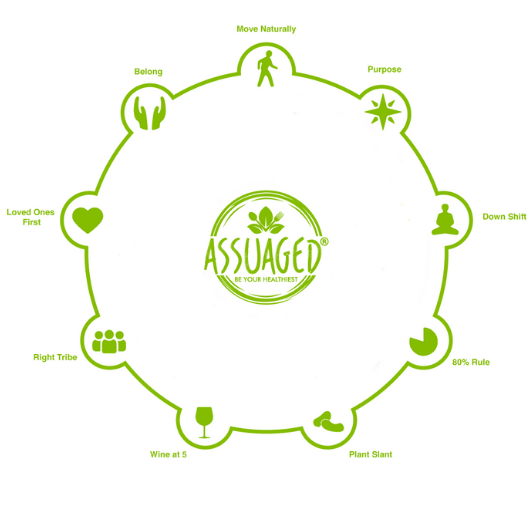
-
Move Naturally
Blue Zone folk aren’t known for going to the gym, getting ripped, and showing off their washboard abs; but, their lifestyle is far from sedentary. They move naturally throughout the day by gardening, walking, and doing housework. -
Purpose
In Okinawa, Japan, citizens have something they call Ikigai, which translates to 'a reason for being.' They encourage one another to find a unifying purpose—sometimes as complex as a grandmother's love for her grandchildren, or as simple as a young boy's love for spicy ramen. -
Down Shift
Okinawans take a few minutes every day to honor their ancestors. The Ikarians take naps, and the Sardinians have happy hour! Everyone deals with stress, even people who live in the Blue Zones, but it's how that stress is handled that matters. Blue Zoners take care of one another and take time to breathe and reflect. -
80% Rule
Quite serendipitously, all of the Blue Zone locations seem to follow this rule to a tee. The Okinawans call it “Hara Hachi Bu,” which translates to 'stop eating when you are 80% full.'
-
Plant Slant
The diet of Blue Zoners is 95 percent plant-based. They only eat meat on average 5 times per month, and only eat about 3-4 ounces per serving. -
Wine at 5:00 pm
Blue Zone folk drink alcohol moderately and regularly. This includes 1-2 glasses per day of organic wine. With friends… and food! -
Belonging
Almost all Blue Zoners belong to a faith-based community. -
Loved Ones First
Most Blue Zone folk keep their relatives nearby or in the home. They also commit to life-partners. This adds many years to their life expectancy. -
Right Tribe
The Okinawans are born into a Moai, a social support group that is more like a group of lifelong friends than a predestined social circle.
The Blue Zones: Why these five locations?
The success of this diet is marked by something very basic: lifestyle. It isn't just a diet. It's a longevity powerhouse of a lifestyle that is proven not through anecdotal evidence, but through the traditions of five communities that live this way. The locations of the longest living people in the world were discovered by Dan Buettner who is an American National Geographic Fellow and New York Times-bestselling author. The Blue Zones diet is a distillation of 150 surveys of people who live in these five locations:
- Ikaria, Greece
- Okinawa, Japan
- Ogliastria, Sardinia
- Loma Linda, California
- Nicoya Peninsula, Costa Rica
People live longer, happier and healthier lives in the Blue Zones. This means 90 to 100 active years practically free of the dizzying array of debilitating physical and mental conditions often caused by aging.
Residents of the five Blue Zones follow not only wholesome native diets, but also carry themselves throughout life with an active sense of community and grounded sense of self. Whether improving our diets or lifestyles, we all have something to learn from the Blue Zone centenarians!
Which one resonates more with your body and mind? Paleo, Plant-Based, Mediterranean, Flexitarian? Let us know about your transition into a healthier lifestyle, and if you are looking for dairy-free, gluten-free or any other diet specific recipes, let us know! We may have one in the works already!









